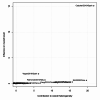Hysteroscopy in the Treatment of Myometrial Scar Defect (Diverticulum) Following Cesarean Section Delivery: A Systematic Review and Meta-Analysis
- PMID: 33282592
- PMCID: PMC7716384
- DOI: 10.7759/cureus.11317
Hysteroscopy in the Treatment of Myometrial Scar Defect (Diverticulum) Following Cesarean Section Delivery: A Systematic Review and Meta-Analysis
Abstract
Various management approaches have been developed to treat symptoms and prevent complications of the cesarean diverticulum. This systematic review aims to report the outcomes and fertility-related effects of hysteroscopy on women with myometrial scar defects after the cesarean section. Following the formulation of the patient/population, intervention, comparison, and outcomes (PICO) criteria, a systematic search was conducted on seven databases. Finally, a total of 18 studies were included for this systematic review and meta-analysis. All of the included patients suffered from post-cesarean section scars and presented with abnormal bleeding, pain, or secondary infertility. The overall pooled symptomatic improvement rate was 78.83% (95% CI: 72.46-85.76%); however, there was significant heterogeneity among the analyzed studies (I2=87%; p-value: <0.001) and a significant risk of bias (p-value: <0.001). The overall resolution/improvement rate after adjusting for possible bias was higher, 92.82% (95% CI: 85.17-100%). The overall pregnancy rate was 69.77% (95% CI: 59.03-82.48%), while in the individual studies the rates varied, ranging from 25% to 80%. Nevertheless, there was moderate heterogeneity among the included studies (I2=56%; p-value=0.011). In contrast, there was no significant risk of bias among the included studies (p-value=0.100). Furthermore, the meta-regression analyses did not show any significant effect of different follow-up durations on the overall effect size for both outcomes. In conclusion, there is still a need for high-quality, comparative studies with larger sample sizes and long-term follow-up periods to draw firm conclusions. Moreover, future studies should consider the minimum myometrial thickness that is sufficient to complete a healthy pregnancy.
Keywords: caesarian scar; diverticulum; hysteroscopy; isthmocele; niche.
Copyright © 2020, Al Mutairi et al.
Conflict of interest statement
The authors have declared that no competing interests exist.
Figures









References
-
- Gibbons L, Belizán JM, Lauer JA, Betrán AP, Merialdi M, Althabe F: The global numbers and costs of additionally needed and unnecessary caesarean sections performed per year: overuse as a barrier to universal coverage: HEALTH SYSTEMS FINANCING. [Nov;2020 ];Gibbons L, Belizán J, Lauer J, et al. https://www.researchgate.net/publication/265064468_The_Global_Numbers_an... World Health Report. 2010 30
-
- Delivery after previous cesarean: long-term maternal outcomes. Silver RM. Semin Perinatol. 2010;34:258–266. - PubMed
-
- Saline infusion sonohysterography in nonpregnant women with previous cesarean delivery: the "niche" in the scar. Monteagudo A, Carreno C, Timor-Tritsch IE. J Ultrasound Med. 2001;20:1105–1115. - PubMed
-
- Cesarean section scar as a cause of abnormal vaginal bleeding: diagnosis by sonohysterography. Thurmond AS, Harvey WJ, Smith SA. J Ultrasound Med. 1999;18:13–16. - PubMed
-
- Detection of cesarean scars by transvaginal ultrasound. Armstrong V, Hansen WF, Van Voorhis BJ, Syrop CH. Obstet Gynecol. 2003;101:61–65. - PubMed
Publication types
LinkOut - more resources
Full Text Sources
